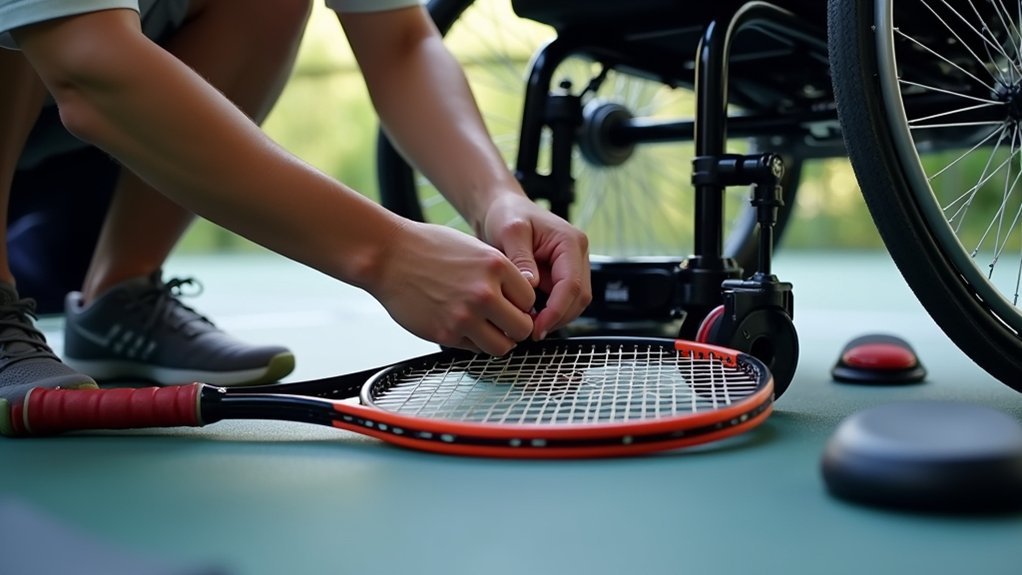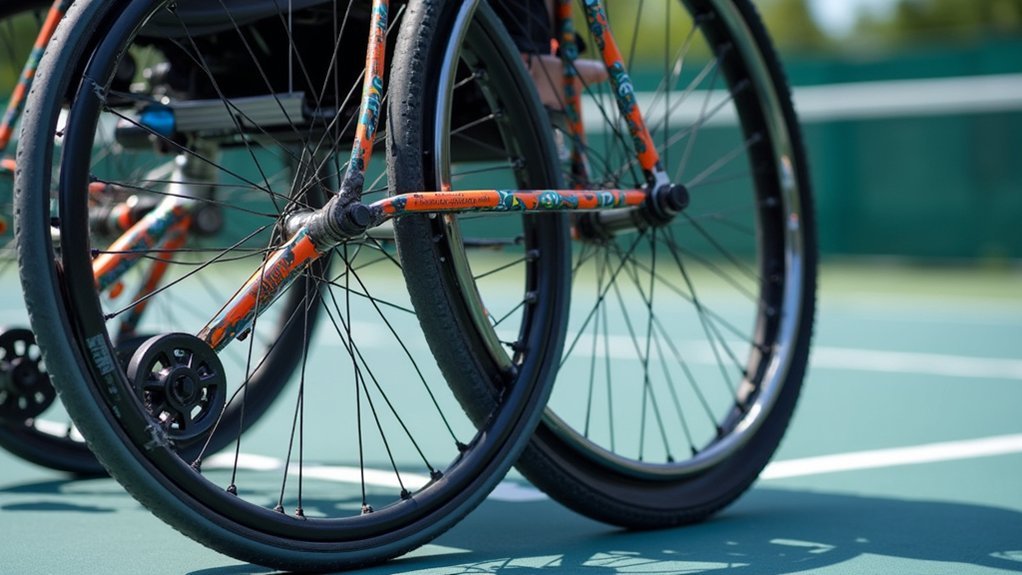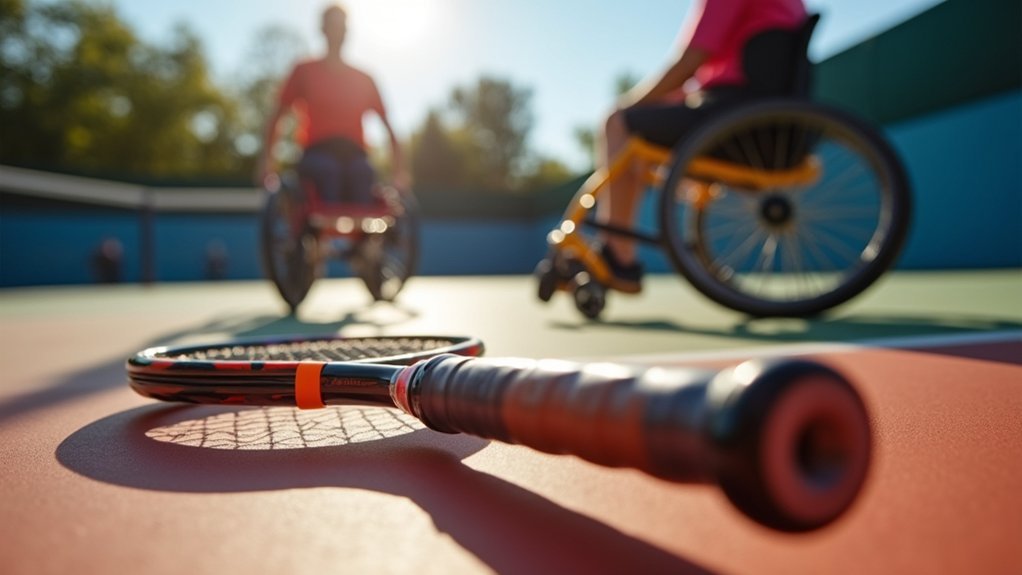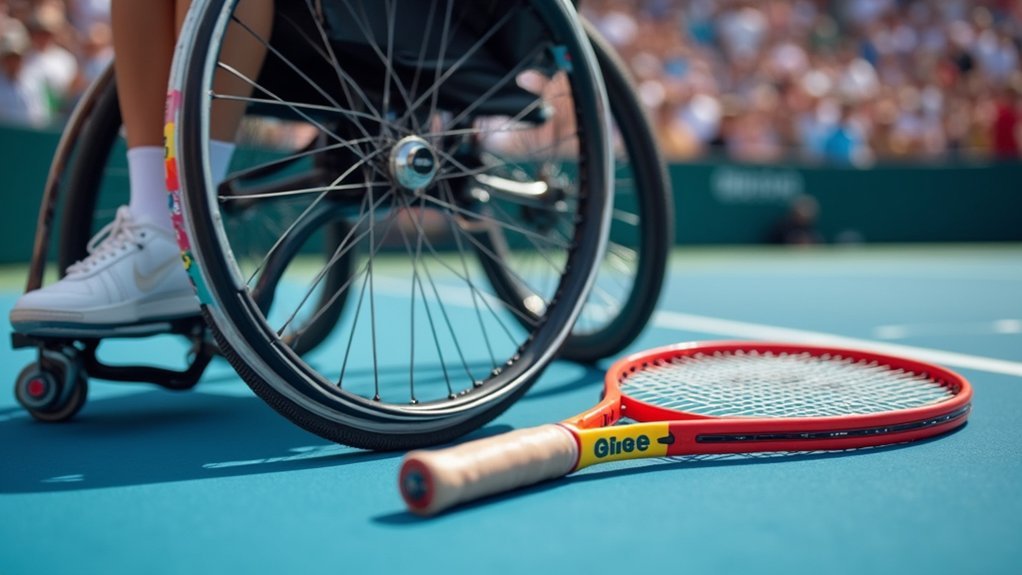Wheelchair tennis athletes need specialized equipment that matches your unique playing style. Focus on lightweight chairs with cambered wheels (18-20° angle) for stability during quick turns. You’ll want adjustable seat height, low backrests for unrestricted serving, and anti-tip casters for safety. Consider adaptive racquets with customized grips and extended handles. Balance performance features against your budget constraints. Professional fittings ($100/hour) can help you identify the perfect setup for competitive success.
Understanding the Unique Requirements of Wheelchair Tennis Athletes

While traditional tennis equipment focuses on mobility and agility for standing players, wheelchair tennis athletes face distinctly different challenges that demand specialized gear.
You’ll need a lightweight wheelchair with cambered wheels that enhance maneuverability and stability during fast-paced matches.
Safety features like anti-tip caster wheels prevent dangerous tipping during those quick directional changes you’ll make on court.
Your custom tennis experience depends greatly on proper wheelchair fit—adjustable seat height and backrest angle accommodate your unique body dimensions and playing style.
Personalized wheelchair configuration is the foundation of successful adaptive tennis, tailoring the equipment precisely to your physical needs and competitive approach.
Look for chairs with low backrests that won’t restrict your serving motion, allowing for effective play without sacrificing comfort.
Adaptable footrests and secure strapping systems further enhance both your safety and performance, making the sport more accessible regardless of your disability.
Evaluating and Selecting the Optimal Tennis Wheelchair
When you’re looking for your perfect tennis wheelchair match, prioritize lightweight models with cambered wheels that enhance your on-court maneuverability.
Consider the balance between performance features like adjustable seat height and backrest angle against your budget constraints, as high-end options offer superior customization but at premium prices.
Before finalizing your purchase, verify proper measurements and adjustments through professional fitting consultations to optimize your comfort, safety, and competitive advantage.
Finding Your Perfect Match
How effectively can you maneuver on the court without the right wheelchair supporting your every move? Your tennis wheelchair should feel like an extension of your body, enhancing rather than limiting your performance.
Prioritize lightweight materials like aluminum or titanium that’ll boost your mobility and acceleration. Don’t overlook cambered wheels—they’re essential for stability and quick directional changes during intense rallies.
You’ll want adjustable features including seat height, backrest angle, and wheel configuration to tailor the chair to your unique physique and playing style. These customizations directly impact your comfort and on-court effectiveness.
Take time to test multiple models and consult with professionals who understand wheelchair tennis dynamics.
Remember that regular fittings and adjustments will be necessary as your skills evolve and your needs change.
Performance Versus Budget
Finding the sweet spot between performance features and your available budget presents one of the biggest challenges in selecting a tennis wheelchair. High-performance models range from $2,980 to $4,499, with pricing largely dependent on materials and customization options.
While budget-friendly tennis wheelchairs might seem appealing initially, investing in higher-quality features often yields better safety and maneuverability—directly impacting your game. Consider that adjustable seat height and backrest angle greatly improve comfort and performance but add to the overall cost.
Before making a decision, schedule a professional fitting consultation ($100/hour) to test various models and identify what works best for your playing style.
Remember that regular maintenance of your wheelchair, including replacing tires and straps when needed, extends its lifespan and maximizes your investment.
Measurements and Adjustments
Proper wheelchair measurements and adjustments transform your on-court performance as meaningfully as your financial investment.
Start by evaluating frame weight—aluminum or carbon fiber options offer superior mobility and speed, critical for competitive play.
Your seat height should align with your body dimensions, ensuring ideal balance during serves and returns.
Don’t overlook cambered wheels, which dramatically improve stability during those critical quick turns and direction changes that define winning points.
Backrest angle adjustments deserve particular attention as they maintain proper posture, reducing injury risk while enhancing your serving mechanics.
For truly personalized measurements, consider professional fitting consultations that analyze your unique playing style and physical requirements.
These precise adjustments aren’t merely technical details—they’re strategic advantages that translate directly to improved court coverage and competitive edge.
Essential Modifications for Enhanced Maneuverability on Court
When setting up your tennis wheelchair, you’ll need to fine-tune your anti-tip casters to strike the perfect balance between safety and freedom of movement.
The ideal wheel camber angle (typically between 18-20 degrees) can dramatically improve your turning radius and stability during competitive play.
You’ll find that these two modifications work together to create a responsive setup that prevents tipping during aggressive serves while still allowing you to execute quick directional changes on the court.
Anti-Tip Caster Tuning
To achieve peak performance on the tennis court, wheelchair athletes must fine-tune their anti-tip caster wheels with precision. The proper adjustment of these vital components prevents tipping during sharp turns and sudden stops, maintaining the balance you need for competitive play.
When customizing your anti-tip casters, focus on optimizing their height and angle. This adjustment directly affects your chair’s center of gravity, enhancing responsiveness during rapid directional changes without sacrificing stability.
Consider selecting different wheel sizes and materials to reduce weight while maintaining support.
Don’t overlook regular maintenance of your anti-tip casters. Consistent tuning guarantees they’ll provide reliable support throughout matches.
Remember that even minor adjustments can notably impact your maneuverability, giving you the edge needed to perform at your highest level.
Optimized Wheel Camber
The perfect wheel camber angle serves as the foundation for exceptional wheelchair tennis performance.
By optimizing your wheels’ outward tilt, you’ll create a wider base that considerably enhances stability during intense rallies and sharp turns. This strategic adjustment increases your wheels’ contact area with the court surface, delivering superior traction and control precisely when you need it most.
You can customize your camber angle based on your playing style—aggressive players often benefit from greater angles that improve acceleration and directional changes.
The right camber configuration also reduces your tipping risk during competitive play, allowing you to focus entirely on your game rather than safety concerns.
Your wheelchair becomes an extension of your athletic ability, responding instantly to your movements with improved agility across the court.
Customizing Wheel Configurations for Different Playing Styles

Since every wheelchair tennis player develops a unique approach to the game, customizing wheel configurations becomes essential for optimizing performance. Your playing style directly impacts the ideal setup for your chair.
Personalized wheel configuration isn’t just an option—it’s a competitive necessity that should reflect your unique playing approach.
If you’re an aggressive player who makes frequent direction changes, you’ll benefit from a wider wheel base and cambered wheels for enhanced stability.
For speed-focused players, consider a narrower configuration with higher pressure tires on hard courts to maximize acceleration and response time.
Court surface also matters—lower tire pressure provides better grip on softer surfaces.
Don’t overlook center of gravity adjustments; lowering it improves stability for sharp turns, while raising it can boost straight-line speed.
Net players and baseline specialists require different configurations to complement their positional tendencies and movement patterns.
Specialized Seating and Positioning for Maximum Performance
While wheel configuration adapts to your playing style, proper seating and positioning create the foundation for all your on-court movements. Specialized seating in tennis wheelchairs can be customized to your unique body dimensions, improving posture and comfort during intense rallies.
| Adjustment | Benefit | Performance Impact |
|---|---|---|
| Seat Depth | Optimized posture | Enhanced stroke mechanics |
| Backrest Angle | Unrestricted movement | Improved serving power |
| Footrest Height | Better support | Increased stability |
You’ll find that adjusting your center of gravity allows for sharper turns and quicker acceleration. Don’t overlook the importance of supportive straps for your waist, thighs, and calves—they’ll keep you secure during aggressive play. Low backrests are particularly valuable, giving you unobstructed movement for powerful serves without sacrificing the control you need.
Adaptive Racquet Designs and Grip Modifications

Three essential elements define adaptive racquets for wheelchair tennis: customized grip dimensions, balanced weight distribution, and specialized handle modifications.
You’ll find these adaptations vital for enhancing control and reducing fatigue during play. Elongated handles provide better leverage for players with limited hand function, while textured grip surfaces prevent slipping during intense rallies.
In adaptive sports, personalized equipment makes all the difference in your performance:
- Modified grip sizes accommodate various hand dimensions for ideal control
- Lightweight composite materials reduce arm fatigue while improving swing speed
- Custom weight adjustments guarantee perfect balance based on your strength profile
- Specialized padding increases comfort during extended matches
These customizations go beyond standard equipment, addressing the unique needs of wheelchair athletes while maximizing maneuverability and responsiveness on the court.
Strategic Strapping Systems for Safety and Stability
Quick-release chest harnesses provide you with essential upper body support while allowing for emergency exits when needed during wheelchair tennis matches.
You’ll find breathable leg stabilizers complement the Pelvi.Loc Ratchet Straps by offering ventilation and comfort during extended play sessions without compromising security.
These specialized strapping components work together with your thigh, calf, and foot straps to create a thorough stability system that enhances your performance on the court.
Quick-Release Chest Harnesses
Although traditional wheelchair setups provide basic stability, strategic chest harnesses represent a game-changing advancement for tennis athletes. Quick-release chest harnesses offer you superior security while ensuring emergency access when needed.
These innovative designs distribute pressure evenly across your torso, preventing discomfort and enhancing mobility during intense rallies.
Your harness can be customized to match your specific needs through:
- Personalized fitting adjustments for your unique body type
- Material selections based on comfort and durability preferences
- Strategic strap configurations that optimize your movement range
- Padded elements positioned to prevent chafing during play
With user-friendly velcro or buckle mechanisms, you’ll enjoy both security and accessibility.
These thoughtful design elements allow you to focus entirely on your game rather than equipment concerns.
Breathable Leg Stabilizers
While upper body stability forms the foundation of your wheelchair tennis performance, proper leg positioning plays an equally important role in your overall control and maneuverability. Breathable leg stabilizers like the Pelvi.Loc Ratchet Leg Strap secure your legs during play, reducing injury risk while letting you focus entirely on your game.
| Feature | Benefit | Performance Impact |
|---|---|---|
| Adjustable straps | Customized fit for all leg sizes | Enhanced comfort during long matches |
| Breathable materials | Improved airflow and temperature regulation | Prevents overheating during intense play |
| Strategic positioning | Maintains proper posture and alignment | Optimizes power transfer in shots |
These stabilizers integrate seamlessly with your equipment, providing the security you need without restricting movement. You’ll experience greater confidence knowing your lower body remains properly positioned throughout competitive play.
Tennis Ball Selection and Accessibility Considerations
When wheelchair athletes select the right tennis balls for their training and matches, they gain significant advantages in skill development and gameplay enjoyment.
Selecting appropriate tennis balls empowers wheelchair athletes to maximize skill development while enjoying more rewarding gameplay experiences.
You’ll find various options designed to accommodate different skill levels and needs.
For wheelchair tennis players with visual impairments, sound tennis balls provide vital auditory feedback during play.
Meanwhile, colored balls offer progression options based on your skill level:
- Red balls (75% slower) – Perfect for beginners learning fundamental techniques
- Orange balls (50% slower) – Ideal for shifting training as skills develop
- Green balls (25% slower) – Final step before standard yellow balls
- Sound-emitting balls – Essential for players with visual impairments
Choosing the appropriate ball guarantees you can participate comfortably while developing proper techniques at your own pace—making tennis truly accessible for athletes of all abilities.
Performance-Enhancing Accessories for Wheelchair Tennis Players
Beyond selecting the right tennis balls, specialized accessories can dramatically improve your performance on the court. Hand rim covers provide superior grip, letting you maintain better control during quick movements and sharp turns.
You’ll benefit from safety straps for your thighs, calves, and feet that secure you properly while playing, reducing injury risk and enhancing stability. Padded ratchet straps around your waist offer additional support during intense rallies.
Don’t overlook wrist guards with adjustable velcro straps that prevent injuries while allowing customized fit for your specific needs.
Anti-tip caster wheels are essential performance-enhancing accessories that prevent unexpected tipping, letting you focus entirely on your game without stability concerns.
These modifications can transform your wheelchair into equipment specifically optimized for tennis performance.
Personalized Training Equipment for Skill Development
To maximize your potential on the court, personalized training equipment serves as the foundation for developing wheelchair tennis skills. Regular consultations with specialists guarantee your gear perfectly matches your unique needs, allowing you to focus on technique rather than equipment limitations.
Sound tennis balls provide vital auditory feedback for improving timing and coordination, especially beneficial if you have visual impairments. Meanwhile, shifting through different ball types helps you progress systematically.
Four essential personalized training equipment considerations:
- Custom wheelchair features (adjustable seat heights, cambered wheels)
- Specialized hand rim covers for enhanced grip
- Progressive ball systems (red, orange, green)
- Padded straps for safety and comfort
With properly fitted equipment, you’ll eliminate distractions and develop skills more efficiently, transforming your practice sessions into productive stepping stones toward competitive success.
Frequently Asked Questions
What Equipment Is Needed for Wheelchair Tennis?
You’ll need a specialized tennis wheelchair with cambered wheels and anti-tip casters, sound or color-coded tennis balls, hand rim covers, secure straps, and padded waist supports. Regular maintenance guarantees peak performance.
How Do Disabled People Play Tennis?
Disabled players use specialized wheelchairs to play tennis with the same rules as standing tennis, except you’re allowed two bounces. You’ll serve, rally, and compete using adaptive techniques suited to your mobility.
What Special Features Make Sports Wheelchairs Better for Athletes Than Traditional Wheelchairs?
Sports wheelchairs give you advantages with lightweight materials for faster acceleration, cambered wheels for better turns, anti-tip casters for safety, and customizable features like adjustable seats that fit your specific athletic needs.
What Is the One Modified Rule for Wheelchair Tennis That Differs From Standard Tennis?
In wheelchair tennis, you’re allowed two bounces before returning the ball, rather than one. The first bounce must be in bounds, but your second bounce can land outside court boundaries if needed.
In Summary
You’re now equipped to customize your wheelchair tennis gear for peak performance. Remember, it’s not just about the equipment—it’s about how it’s tailored to your unique style and needs. Don’t hesitate to experiment with different modifications until you find what works best. With properly customized gear, you’ll improve your court mobility, comfort, and ultimately, your competitive edge.





Leave a Reply